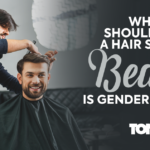
How to Control Frizzy Hair?
External factors such as humidity exacerbate the issue as the hair absorbs excessive moisture from the air. This guide explores five practical and effective tips to managing frizzy hair, shedding light on actionable strategies to tame frizz and elevate your hair care game.
1. Hydration Is Important
Dehydration is perhaps the most direct cause of frizz. When dehydrated hair absorbs moisture from the atmosphere, the cuticle layer swells up, leaving a surface uneven with a frizzy texture. Hence, hydration from both sides, inside and outside, is vital for managing curly hair.
- Use Moisturizing Shampoos and Conditioners:
Use sulphate-free products that are made to hold onto the natural oils that are in the hair. Find conditioners with humectant-based ingredients, like glycerine, and emollient-based ingredients, like shea butter or coconut oil, which hydrates hair from the inside and gives it much moisturising power.
Moisture-based products protect against dryness, and their first level of defence is to provide the hair with a silky shine.
- Make Weekly Deep Conditioning Treatment Use:
Intensive treatments promote reconstruction and moisture restoration back in the hair shafts. Product examples include keratin-enriched or infused products which strengthen and hydrate from the inside out.
Apply some amounts of the treatment. When rinsing under running water, let the treatment sit for 20-30 minutes. All the processes penetrate and replenish the deficiencies caused inside hair shafts due to lack of moisture.
- Internal hydration:
Hair reflects hydration in the body. Drink enough water to keep the hair moist throughout the day. Moisture adds up and reduces dryness. Make a diet with food items with water content, like cucumber and watermelon, to hydrate the body.
- Least Over-washing:
Overdoing the washing of hair can strip away the natural oils of the hair, thus becoming a victim of dryness and frizziness. Wash the hair only 2-3 times a week, interlocked with dry shampoo use in between shampooing
so the freshness can be allowed inside the hair—co-washing, wherein the conditioner can act as a substitute for shampooing when the hair becomes extremely dry.
Also Check – The importance of regular hair trims: when and why do you need them?
2. Right Haircare Tools and Methods

Tools and techniques associated with hair care are indispensable for controlling frizzy hair. It becomes a problem if any tool is inappropriate or wrong and is handled poorly enough to cause undue breakage and dryness.
- Go for a microfiber towel or T-shirt:
Towels tend to rip up the cuticles, and this causes frizz. Microfiber towels or soft cotton T-shirts are kinder to hair and less likely to tear it. They will soak up extra water without rubbing up the hair shaft and make it smoother rather than prone to frizz.
- Gentle Detangling:
Wet hair is stiff to get detangled. Use a wide comb or a brush to remove the hair from all the tangles. Start from the end and work up in sections. A leave-in conditioner could add slip, which smoothes out the process. Always part hair in sections to guarantee even handling.
- Learn the Blow-Drying Method:
If blow-drying is not done correctly, it can increase frizz. Use a diffuser attachment to help distribute heat and enhance your natural hair texture. Finally, set it with a final blow of cool air that closes the cuticle, reducing frizz. For straight hair, you can use a nozzle attachment to blow air down the length of the hair, smoothing the cuticle.
- Reduce Heat Styling:
Braids, buns, or twist styles are not only super fly; they also minimise exposure to external stressors that provoke frizz. They facilitate excellent moisture retention and prevent knotting or tangling. Protective styling suits curlier or coyly locks much better because they are more prone to dryness and breakage.
3. Use an Anti-Frizz Styling Regimen
Styling is the most significant management of frizzy hair. The proper products and techniques can work wonders to give a sleek, glossy look.
- Anti-frizz serums for shine and control:
These serums contain silicones. These silicones coat the hair shaft to seal in moisture and act as a humid barrier. Use a tad of it to avoid weighing your hair downwards. They are helpful when living in moist environments where the frizz is at its worst.
- Leave-In Conditioners for Everyday Hydration:
These are versatile, lightweight conditioners with continuous moisture and daily protection. They do exceptionally well in curly and wavy hair. Apply leave-in conditioner on damp hair and spread them evenly for better results.
- Styling creams or gels to control frizz:
Use creams or gels to dampen hair and gently crimp to achieve defined curls or waves. Smoothing creams can leave straight hair sleek while controlling flyaways.
4. Protect Your Hair from Environmental Stressors

External factors like humidity, sun exposure, and pollution significantly contribute to frizz by weakening the hair structure and cuticle. Proactively shielding your hair can help minimise these effects.
- Use an Anti-Humidity Spray:
This spray forms a lightweight barrier that repels moisture in the air. It keeps the frizz under control even during challenging weather conditions. Anti-humidity sprays are handy for outdoor events or humid climates.
- Protective Accessories:
Scarf or head wraps with a hat protect your hair from the wind, sun, and rain. Opt for breathable cotton or silk. Do not let it dampen or sweat because it irritates your scalp. Such accessories keep your hair protected but look so cool when wearing.
- Do Not Damage with Chlorine or Salt Water:
Natural oils in hair are removed by chlorine and salt water, which can damage and dry out hair. Use a leave-in conditioner before swimming and a swim cap, if possible, to minimise exposure.
5. Healthy Haircare Routine
Consistency improves the overall health and management of frizzy hair. A system creates long-term benefits and minimises the recurrence of issues. Regular and thoughtful hair care will give the foundation to frizzy hair. Over time, these habits promote healthier, more colourful, easier-to-style hair.
- Trims should be done periodically:
Split ends move up the hair shaft, making frizz more severe. Therefore, trim needs to be scheduled every 6-8 weeks to have smooth, healthy hair. Trimming your hair regularly not only makes your hair look good but also promotes general growth and strength.
- Natural Remedies for Extra Nutrition:
Coconut oil, honey, or avocado-based homemade masks can nourish hair to a deeper level and give it better texture. For example, a yoghurt and olive oil blend can revitalise and shine your hair. These natural, inexpensive, and chemical-free remedies are best for sensitive hair.
- Avoid Harsh Chemical:
Sulphates, parabens, and alcohols dry and break hair. Avoid harsh chemicals; seek formulas that moisturise and protect your hair. As you read labels, you make selections that will help you meet your hair goals.
- Invest in a Silk Pillowcase:
Silk or satin pillowcases reduce friction when you sleep, thus preserving moisture without breakage. This slight change can bring about noticeable improvements over time. Silk pillowcases are very helpful for people who get knots and dryness.
Say Goodbye to Frizzy Hair at Toni&Guy!

A little of everything: luxurious hair care, a glowing face and timeless beauties; here is what we would love to pamper at Toni&Guy. We will deliver on this promise because we care about you and want you to look, feel, and be refreshed, confident, and effortlessly chic.
You deserve nothing less than the best, and that’s what Toni and the guy do—tailor-made services from sleek, frizz-free styles to rejuvenating skin treatments. Visit Toni&Guy today and transform into your fabulous, frizz-free version. Because impressive is what you deserve!
Conclusion
It may be daunting initially, but managing frizzy hair is entirely doable with the right approach and constant care. It focuses on hydration, proper choice of tools and techniques, a targeted styling routine, and protection from environmental stressors.
In turn, taming frizz and generally making your hair healthy will always benefit you since a structured hair care routine also ensures lasting benefits: it keeps your hair manageable.
It brightens up each day with its health. It is not about achieving a sleek appearance; it is about nurturing and appreciating the natural beauty of your locks.
With devotion and the tips outlined above, you can transform the frustration of frizz into an opportunity to enhance your haircare skills and confidence. Adopt these tips, and get on the way to smoother, shinier, healthier hair.
FAQs on Controlling Frizzy Hair
1. Is hot styling damaging the curly hair?
Using too much heat dries the hair out, so it becomes worse. Always spray heat protection before your appliances for hot styling, and set your appliance at the lowest temperature.
2. Do such things as hair care products for curly hair exist?
Watch for glycerin, shea butter, argan oil, moisturiser, and hair conditioner. Among the better ones are anti-frizz serums, creams, and hair masks.
3. Can someone style with frizzy hair when it’s wet and hot outside?
Use anti-humidity serums/sprays
Try to wear a protective hairstyle such as braids or buns. Keep it well-moisturized, and dry hair will absorb moisture from the air
4. Do homemade remedies for frizzy hair work?
Of course, it would hydrate the hair and keep frizz off using natural remedies, such as coconut oil, aloe vera or a honey mask, something one could apply once a week.
5. How soon can one visit a hair professional because of having a lot of frizzy hair?
If hair remains unruly by home remedies, the next step would be treatment in a salon through a hair spa or keratin therapy. Professionals can guide you through suitable solutions for your hair.


